My search for a 1966 GT350 began sometime around the spring of 1987. Initially I had wanted a 4-speed 1967 GT500. A man in Cave Spring, Georgia (who I bought my 1970 Boss 302 from) had one for sale at this time. I made the trek over to Cave Spring, about 100 miles, to check out the car. An initial drawback to this car was its color -- Lime Green. This seems to be the color of about 50% of all 1967 Shelbys. This car was a four-speed with the correct dual-quads, Kelsey-Hayes MagStars and under-dash gauges. My brother, Jeff and friend, Mark Key, accompanied me on this trip. On the test drive, my accomplices took the back seat while the owner and I had the front.
The first portion of the drive was uneventful (if you can call driving a 4-speed Shelby uneventful). On our return, the smell of hot wires was noticed and soon the whole passenger compartment was filled with smoke. It even appeared to be coming out of the roll bar casing! Our eyes were watering and we were coughing from the smell -- reminiscent of a plastic spoon melting in the dishwasher. The problem was a short in the underdash gauges. They had gotten so hot that the lenses on them had started to melt. Needless to say I passed on this car. But while we were there we looked at some of the other cars this guy had; some 7 Shelbys, 2 Bosses and numerous other "plain" Mustangs. One of these was a 1966 GT350H that had been completely restored (including the undercarriage). It was the nicest car I had ever seen. The price was outrageous at the time - $21,000. The car was eventually bought by a friend and won Best of Show and People's Choice at our Rocket City Mustang Club 1988 Annual Show. The guy also had a driver 1966 GT350H with dual Carter 4-barrels on it 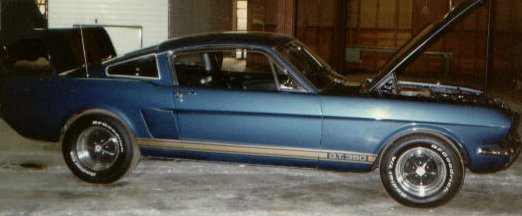 . I barely gave it a second glance. The price was $11,500 and I figured I could find a better one if I looked around.
. I barely gave it a second glance. The price was $11,500 and I figured I could find a better one if I looked around.
A couple of months later a friend gave me a copy of the Tennessee Auto Trader. On the first page was a red/white '66 GT350 -- chrome Magnums, four-speed, described as "fully restored" (that dreaded, over-used and usually incorrect description). The asking price was $15,000. Although the price seemed somewhat high, being in Nashville it was close enough (100 miles) to take a look anyway. On the way to see this car, Mark Key and I stopped off in Columbia, Tennessee to look at a 1972 Pantera that was advertised in Hemmings as having "17,000 original miles." The gall of some people really amazes me. How can you wear out the carpet in only 17,000 miles? It was at least 117,000 and looked like even more. Since I had never driven a Pantera before I decided to act interested anyway. During the test drive a strange clunking noise could be heard coming from the engine compartment behind us. The owner assured me he had never heard this before. I thought to myself, "Sure thing, Buddy." When we returned we found that the cable going to the rear mounted radio antenna had been caught in one of the ZF transaxle's half-shafts and had been yanked from the antenna. It was flopping around the engine compartment, causing all kinds of strange noises.
On to Nashville that afternoon to see the Shelby. The car had been "restored" by a restoration shop up north and was the cover car for their brochure. It looked good initially but the rear end had been replaced by one from some other car and was too wide. Air shocks had to be put on the car to raise the rear so the tires would not rub. Fittings for the air lines had been put into the rear valence. The interior had been dyed black; the dash pad and kick panels appeared to have originally been blue (as seen in the places where the black was peeling off). There were some rust bubbles coming up underneath the stripes at the lower corners of the doors. When I pointed these out I was assured that they must be "some dirt that got trapped in there." Upon driving the car, I noticed excessive front end wheel play which, I was assured, was "caused by the radial tires." I decided to pass on this car without even making an offer. A week later the guy called me at work and asked if I'd give him $11,500 for the car. It seemed he was getting a divorce and needed the money. Again I passed. I figured I could find a better one if I looked around.
At this time I decided to become more knowledgeable about the cars, so I ordered lots of literature, including the Shelby Buyer's Guide, Shelby American Guide, Shelby American World Registry and several other books. From this point on serial numbers would become more significant to me.
I decided to go to SAAC-12 at Charlotte, hoping there would be many cars there to choose from. There were. To see all those cars in the three-level parking garage at the headquarters hotel was unbelievable. You could not fully describe this to someone who has never seen it in person. On the show day I had noticed a very nice, red 1966 GT350 with a "For Sale" sign on it. This car had been runner-up in the popular vote car show at SAAC-11 in Dearborn. When I finally tracked down the owner I learned that the car had just been sold. 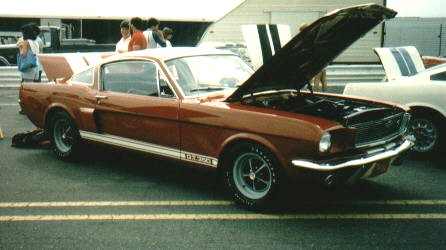 Good Grief! Out in the parking lot I spied another "For Sale" sign on a white '66 without LeMans stripes. The owner was passing out a ten-page list showing each and every piece that was used in restoring the car -- some $30,000 worth. But the car had 351-W heads and an aftermarket distributor, and I passed. I figured I could find a better one if I just looked around.
Good Grief! Out in the parking lot I spied another "For Sale" sign on a white '66 without LeMans stripes. The owner was passing out a ten-page list showing each and every piece that was used in restoring the car -- some $30,000 worth. But the car had 351-W heads and an aftermarket distributor, and I passed. I figured I could find a better one if I just looked around.
Following SAAC-12 I began to go back through old issues of Hemmings and circle ads that seemed attractive. Three of the cars that I found would later figure in my frustration. Each was still for sale (at $14,500, $14,000 and $19,000, respectively) and each had some niggling imperfections that had caused me to write them off at the time. Except one. This car sounded good, though a little expensive. The owner seemed to know very little abeut the car or didn't want to tell me much about it. Supposedly it only had 37,000 miles on it and had been restored. But my inability to communicate with the owner caused me to continue looking at other cars.
My closest encounter came to pass in November of 1987. An ad in Hemmings for a very early 1966 GT350 appeared. 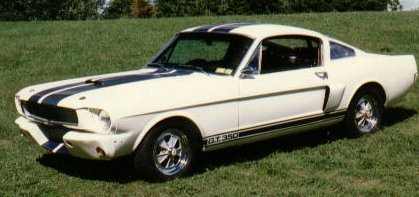 The car had been completely stripped and repainted, the undercarriage detailed, and it had Ray Brown belts, a real '65 Shelby wood steering wheel, five Cragar/Shelby wheels, a '65 rear shelf, R-Model gauges, a roll bar and an R-Model rear window. The owner had completely documented his restoration on video-tape and with 35mm photographs. He sent me two videos (taken in the cold New York State winter). I was really impressed with the car. When he said that someone in Europe was interested in it I sent a $200 deposit to hold it for a couple of weeks. I showed several local club members (who shall remain unnamed) the videos of the car and was talked out of buying it -- because of all the '65 and R-Model stuff on it. Peer pressure got to me. The price of $19,500 (steep but not outrageous) seemed to them to be too high for a car which wasn't completely stock. Of course, I could have still bought it anyway. This was one bit of advice that I will regret having followed for the rest of my life. Some two years later I showed these videos at one of our Rocket City Mustang Club meet-ings. People could not believe that I didn't buy the car. I still feel sick every time I think of it. Coincidentally, after viewing the video, one of our new members, Marc Snyder, who had recently moved to Huntsville from Germany, turned out to be the European party who had been interested in the car!
The car had been completely stripped and repainted, the undercarriage detailed, and it had Ray Brown belts, a real '65 Shelby wood steering wheel, five Cragar/Shelby wheels, a '65 rear shelf, R-Model gauges, a roll bar and an R-Model rear window. The owner had completely documented his restoration on video-tape and with 35mm photographs. He sent me two videos (taken in the cold New York State winter). I was really impressed with the car. When he said that someone in Europe was interested in it I sent a $200 deposit to hold it for a couple of weeks. I showed several local club members (who shall remain unnamed) the videos of the car and was talked out of buying it -- because of all the '65 and R-Model stuff on it. Peer pressure got to me. The price of $19,500 (steep but not outrageous) seemed to them to be too high for a car which wasn't completely stock. Of course, I could have still bought it anyway. This was one bit of advice that I will regret having followed for the rest of my life. Some two years later I showed these videos at one of our Rocket City Mustang Club meet-ings. People could not believe that I didn't buy the car. I still feel sick every time I think of it. Coincidentally, after viewing the video, one of our new members, Marc Snyder, who had recently moved to Huntsville from Germany, turned out to be the European party who had been interested in the car!
The next car was just as nice and I came very close to buying it as well. From another Hemmings ad I learned of a white '66 with blue LeMans stripes that was for sale in Virginia. This car had a real wood '66 steering wheel, five 10-spoke wheels, detailed engine compartment, trunk, etc.. It had been pictured on the front cover of The Marque (Vol. 4 No. 1). My girl-friend had some friends living in the D.C. area so we decided to make the trip up there, buy the car, and then drive both cars back home. We were to leave on Friday morning. On Thursday evening I had a message that some dealer from Arizona was flying out to look at the car on Friday and that I should wait and call back after that to check on its availability. 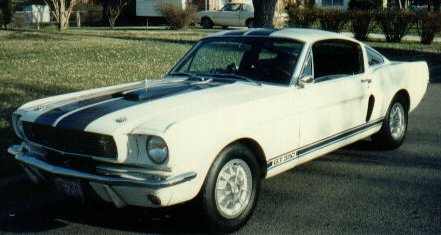 We decided since we had already made plans that we would go ahead and leave Friday morning anyway. After a 730-mile trip we reached D.C. and I immediately called the seller. I got his wife. He was showing the car at the time. About 30 minutes later I got word that the car was sold. So I spent the next two days dejectedly touring Washington D.C. Hindsight said I should have put a deposit on this car as well.
We decided since we had already made plans that we would go ahead and leave Friday morning anyway. After a 730-mile trip we reached D.C. and I immediately called the seller. I got his wife. He was showing the car at the time. About 30 minutes later I got word that the car was sold. So I spent the next two days dejectedly touring Washington D.C. Hindsight said I should have put a deposit on this car as well.
It was about this time that the prices of Shelbys really started rising, along with the advent of the price gouging dealers and speculators who were cropping up left and right. A blue and white 4-speed '66 was another one of the cars I mistakenly passed on. When I inquired about the car the price was $15,000. Word spread a few months later that a dealer had sold the same car for $32,000. As news like this came out, the price of every '66 in the country began to jump. The days of the $15,000 '66 GT350 vanished practically overnight. So, it seemed, did the supply of privately owned cars for sale. The hobby was quickly being ruined -- all in the name of profit. Now people who had no knowledge or true interest in the cars were buying them up with seemingly unlimited funds. It was at this point that panic set in. Was I to be faced with the prospect of buying a less than ideal car now because that was all I could afford? I was still not totally convinced of this and was destined to hesitateand to make still more mistakes because of it.
It was in May, 1988 that a fellow club member found a 1965 Shelby right here in Huntsville. Although not advertised, the owner agreed to sell it to him for $13,500! Although it had the wrong engine and was a little rough, it was otherwise mostly complete with R-Model wheels, correct steering wheel, gauge pod, rear shelf, etc. It ran and drove as well. About a month later in the process of getting a divorce, the owner offered the car to me for $16,000. Again, being the fool that I am, I passed thinking that I could find a real nice '66 for just a few thousand more. The car was eventually sold to a dealer in Virginia for $18,500. There is no telling how much he made off the car.
A couple of months later I saw an ad in Hemmings (I was now getting it First Class for $52 a year) for a '66 GT350, a white 4-speed car with an Alabama phone number. Not wanting this seemingly great opportunity to pass by, I immediately called the number in the ad. I reached a doctor's office. The receptionist told me the doctor would not be in again until Monday. Not wanting to wait that long, I went to the library to look up his home phone number in the Birmingham phone book. I found him at home and asked if I could come and look at the car. I was the first caller on it. I was informed that he would be out of town until Monday, at which time I was to call back and make arrangements to see the car. The original asking price was $23,000. When I called back on Monday he told me that his answering machine tape had filled up over the weekend with calls about the car. He was afraid he had under-priced it and had decided to take it off the market, but he would call me first when he decided to reenter it. About a week later he called and said he had decided to raise the price to $28,000. I told him thanks, but no thanks. I wasn't going to be held hostage. Additionally, I learned that the car had originally been red and was now white.
At this time I decided to take a chance and go back again to some of the old ads I had previously passed on. The owner of a car in Virginia still had it but had decided not to sell it at this time. I was assured that I would be the first one called should he change his mind. I had originally passed on a green car in Iowa because it had been repainted Emberglow. This car was still for sale but the price was now $20,000. I asked for some photos and was assured the car was all correct and rust free. During thecold month of January, 1989 I bought a $600 plane ticket to Iowa. It was extremely cold and there was about a foot of snow on the ground. The car was inside an old Ford dealership along with about 50 other old cars). I only looked at the Shelby for about 15 minutes. Every panel on the car except the roof and trunk lid had rust on it. The carpet was hanging through the floorboard and there was a hole in the left inner quarter panel big enough to put a fist through (which was what I felt like doing about that point). Doors, rockers, lower fenders and quarters were all rusty. The interior was out of a 1965 Mustang. I hastily said thanks and left, wondering if this guy realized that his misrepresentation had just cost me $600. About three months later I saw this car again advertised as rust free. Discretion prevented me from calling this joker up and giving him a piece of my mind.
My next re-check was on a car in Michigan. The owner still had the car and would sell it. The price was now $28,000. I asked for some pictures and he sent two. I called back and expressed my interest, but said that I would like more pictures before flying up to see it. A month went by and still no photos. I tried to call on several occasions but got a recording saying the number had been disconnected. The recorded voice sounded strangely like the crackly voice of the owner. (Can you say "eccentric"?) I finally got an envelope from him with a short note telling me the car had been sold. Logistics had cost me this opportunity.
Nothing much happened between then (April, 1989) and SAAC-14 at Pocono. At the convention the only 1966 cars I saw for sale were three belonging to the same person. One was the last car I called on, in Michigan ($28,000). It now carried a price tag of $40,000. I was crushed by the thought that someone had bought a car out from under me just to turn a quick buck. This car really was restored and only had 37,000 miles on it.
Right after SAAC-14, I found a 1970 Boss 302 for a reasonable price in Indiana. 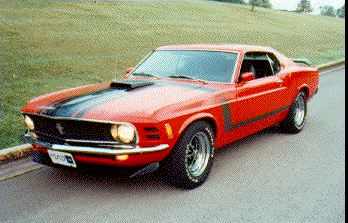 Two local club members had mentioned, on several occasions, of their interest in such a car. Not wanting to let it get away I bought it, thinking that one of them would like to have it (for the same price I paid for it). After I got it home both seemed to lose interest -- so there I was with the car. As Murphy would have it, this was the very time a '66 GT350 appeared for sale in Hemmings. This was one of the cars I had been promised the right of first refusal on. Now I needed to unload the Boss in order to have the necessary funds. This took me until the end of October, by which time -- of course -- the Shelby had been sold. For $28,000. It reappeared a month later in Hemmings, now for sale by a dealer, for $39,000. By this time you should begin to see the pattern.
Two local club members had mentioned, on several occasions, of their interest in such a car. Not wanting to let it get away I bought it, thinking that one of them would like to have it (for the same price I paid for it). After I got it home both seemed to lose interest -- so there I was with the car. As Murphy would have it, this was the very time a '66 GT350 appeared for sale in Hemmings. This was one of the cars I had been promised the right of first refusal on. Now I needed to unload the Boss in order to have the necessary funds. This took me until the end of October, by which time -- of course -- the Shelby had been sold. For $28,000. It reappeared a month later in Hemmings, now for sale by a dealer, for $39,000. By this time you should begin to see the pattern.
In December of 1989 I located three other '66 cars within 70 miles of my home. Each's owner said he was not interested in selling. Another car, in Birmingham, was advertised in the Snakebite Bulletin. Its owner refused to even return my calls. I guess he changed his mind.
At this time I had nearly resigned myself to go back to the less expensive, but more plentiful, '67 cars (not that I don't like them, mind you). But first, I decided to swallow my pride and call on one of the '66s I had seen at SAAC-14 (originally $19,000 after SAAC-12, then $28,000, then $40,000). Maybe a sob story would get me a good price on the car if it was still for sale. It didn't. But the owner had another blue four-speed car available. It needed paint and was supposedly rust free. I thought, "What the heck - go for it." I purchased a plane ticket to Michigan. When I arrived there was snow on the ground and the temperature was near zero. The seller picked me up at the airport and casually mentioned the car had cracked a piston that morning when the accelerator hung open (it was the first time it had been started in over two years). It needed paint, was missing the seat belts, wheels, and yes -- it had some rust. I just couldn't bring myself to pay $31,000 for a car that I couldn't even start up. I thanked him and went back to the airport, only to find that my flight had been cancelled. I decided to sleep in the airport terminal. At about 11 p.m. a security guard asked me what I was doing and informed me that the terminal closed at midnight. I had to run back to the Northwest ticket counter. They graciously put me up for the night in a nearby motel.
For the next couple of weeks I pondered beginning anew a search for a '67 Shelby or a Pantera. I even called on a few but no real hot prospects presented themselves. During the second week of January, 1990 I ran an ad in the Atlanta Constitution, offering $500 for information leading to my purchase of a '66 GT350. I was hoping that maybe I could pull one out of the woodwork that no one else knew about. I received five responses. One guy referred me to the owner of the first car I had looked at -- the '67 GT500 with the smoking gauges. Another proceeded to read me ads from the DuPont Registry (which I already had) and one guy tried to sell me a white GT350 Hertz car, which was owned by someone else, inOklahoma. I had spoken to that car's owner the day before this guy called and had been quoted a price $6,000 less that what this guy said. Apparently my $500 wasn't enough for him.
At the end of January I got the latest issue of the Snakebite Bulletin. I quickly spied an ad for a '66 GT350 in Georgia. I called immediately and talked to the car's owner, Gene Boone. It was a black and gold Hertz car, currently powered by an out-of-the-crate '70 Trans-Am Boss 302 engine. He had a 289 Hi-Po to go with the car. He had driven the car to SAAC-14 (a 1,600 mile round trip) and at the Walter Mitty Challenge at Road Atlanta. His asking price was kind of high, but he let me know that he realized it was optimistic and that he would be willing to talk. ! arranged to drive to Atlanta on Thursday, January 26th.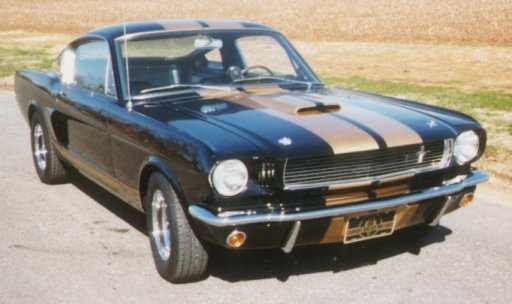
Thursday was a bleak, dreary, rainy day but I was determined to go anyway (200 miles, one way). After fighting 1-285 traffic, I found Gene's house at about 10:30 a.m.. The first time I saw the car I knew "this was it." Although it was driven regularly, the owner was very particular about its condition. A man after my own heart. He had anticipated my question and had removed one pop-rivet from the Shelby serial number plate so that I could check the car's Ford vehicle identification number. It was O.K.. After a few hours of talking cars and parts (he also owned a Griffith, a Tiger, a Shelby race car and a '67 GT500) I made him an offer. He accepted it only after I was able to convince him that I was not some dealer trying to turn a quick buck. He was also concerned about the car having been in Georgia and Alabama its whole life. I assured him it would stay in Alabama with me. After my assurances, a deposit was given and the deal settled. I was to pick up the car a week later. That night I got a call from Gene and he had actually arranged to buy some additional parts for the car and include them with it - at no additional cost! How often do you find that?
Saturday, February 3rd was even more rainy (at our 3 a.m. departure time) than the day I had first looked at the car. Club member Ray Bryan and his son, Matthew, agreed to help me pick up the car in their brand new enclosed trailer. We were so keyed up that we actually arrived two hours early. Mr. Boone proceeded to give Ray some Boss 302 parts while we were there and even had the Shelby's gas tank full. He later called to make sure we got back home okay that evening. Then he read me a letter his daughter had written to him after I had taken the car. It seemed the money from the car was to be used to send her to college. She really felt bad about causing him to have to sell his car and promised she would really work hard in return.
I guess the moral of the story is that those who persevere will win out in the end, although their pocketbooks may be a little thinner.